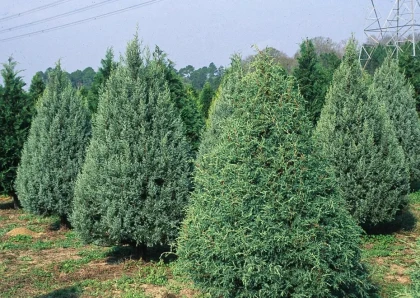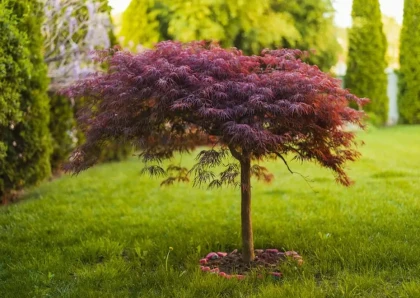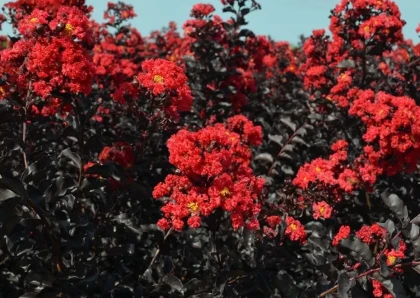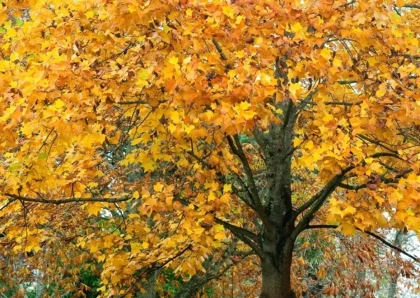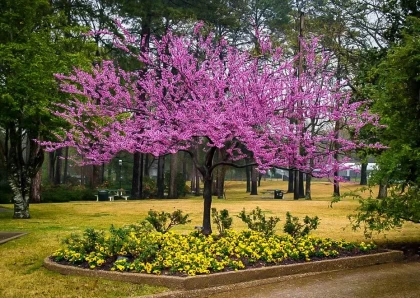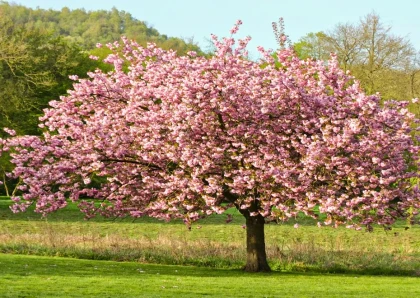
Sioux Crape Myrtle Tree
Overview
History of the Tree
The Sioux Crape Myrtle Tree (Lagerstroemia 'Sioux') is a stunning flowering tree that originated in the United States. It was first developed by horticulturist Dr. Donald Egolf at the U.S. National Arboretum in the 1960s. Since its introduction, it has become a popular choice among gardeners and landscapers for its vibrant blooms and attractive features.
Detailed Description of the Tree
The Sioux Crape Myrtle Tree is a deciduous tree that showcases a profusion of vibrant flowers in the summer months. It typically grows to a height of 10 to 20 feet (3 to 6 meters) with a spread of 8 to 12 feet (2.5 to 3.5 meters). The tree has a multi-stemmed, upright growth habit and develops smooth, mottled bark that adds visual interest to the landscape.
Types of this Tree
The Sioux Crape Myrtle Tree is a cultivar of the Lagerstroemia genus, which comprises various species and hybrids. Some popular types of Crape Myrtle trees include Natchez, Tuscarora, Muskogee, and Dynamite. Each type differs in flower color, growth habit, and overall characteristics.
Importance of this Tree
The Sioux Crape Myrtle Tree holds great importance in landscaping and horticulture for several reasons:
- The tree's vibrant and abundant blooms add beauty and color to any garden or landscape.
- Its multi-stemmed growth habit and attractive bark provide year-round visual interest.
- The tree's compact size makes it suitable for small gardens or as a focal point in larger landscapes.
- It is highly resistant to diseases and pests, ensuring its long-term health and minimal maintenance.
How to Care for this Tree
To ensure the health and vitality of the Sioux Crape Myrtle Tree, consider the following care tips:
- Sun Exposure: Plant the tree in a location that receives full sun for at least six hours a day.
- Soil Requirements: The tree thrives in well-draining soil with a slightly acidic to neutral pH level.
- Watering: Provide regular watering, especially during dry spells, to keep the soil evenly moist.
- Pruning: Prune the tree in late winter or early spring to remove dead or damaged branches and promote healthy growth.
- Fertilization: Apply a balanced slow-release fertilizer in early spring to provide essential nutrients.
Benefits of the Tree
The Sioux Crape Myrtle Tree offers numerous benefits to the landscape and the environment:
- The tree's vibrant flowers attract pollinators such as bees and butterflies, contributing to a healthy ecosystem.
- It provides shade and relief from the summer heat when planted strategically near patios or outdoor seating areas.
- The tree's attractive bark adds visual interest even during the dormant season.
- Its compact size and beautiful flowers make it a popular choice for urban gardens and small landscapes.
How to Plant this Tree
Follow these steps to successfully plant the Sioux Crape Myrtle Tree:
- Choose a location that offers full sun and well-draining soil.
- Dig a hole that is twice as wide and slightly shallower than the root ball.
- Place the tree in the hole, ensuring the top of the root ball is level with or slightly above the ground.
- Backfill the hole with soil and gently firm it around the roots.
- Water thoroughly to settle the soil and remove any air pockets.
- Apply a layer of mulch around the base of the tree to retain moisture and suppress weed growth.
- Monitor the tree's growth and provide regular care as outlined above.
Different Types of Wood Products
The wood of the Sioux Crape Myrtle Tree is not commonly used for commercial purposes due to its small size and ornamental value. However, crafters and woodworkers may utilize the wood for smaller projects, such as turning it into decorative items, small sculptures, or woodwork inlays.
Cons
While the Sioux Crape Myrtle Tree has many desirable qualities, it's essential to be aware of some potential cons:
- The tree may be susceptible to powdery mildew and aphid infestations, which can affect its overall health and appearance.
- In colder climates, the tree may require winter protection, such as mulching the base and covering it with burlap, to prevent frost damage.
- Like most plants, the Sioux Crape Myrtle Tree requires regular maintenance, including pruning and watering, to thrive and reach its full potential.
FAQs (Frequently Asked Questions)
Q: When does the Sioux Crape Myrtle Tree bloom?
A: The Sioux Crape Myrtle Tree typically blooms in the summer, starting from late June to early July, and the flowering period extends for several weeks.
Q: How often should I water my Sioux Crape Myrtle Tree?
A: Water your Sioux Crape Myrtle Tree regularly, especially during hot and dry periods. Aim to keep the soil consistently moist but not waterlogged.
Q: Can I grow a Sioux Crape Myrtle Tree in a container?
A: While it is possible to grow a Sioux Crape Myrtle Tree in a container, it may require more frequent watering and care compared to when planted in the ground. Ensure the container has proper drainage and choose a suitable size to accommodate the tree's growth.
No listings available
Related Products
Questions & Answers
What do you want to know about this product?
Reviews (5)
LeafyLover77
Blooms that Paint the Sky
The Sioux Crape Myrtle's vibrant blooms create a mesmerizing canopy of color. It's a breathtaking spectacle in my garden.
Arborista121212
Unmatched Elegance and Charm
The Sioux Crape Myrtle exudes elegance with its graceful form and delicate flowers. It adds a touch of sophistication to any landscape.
NatureEnthusiast21
A Beacon of Beauty in All Seasons
With its year-round appeal, the Sioux Crape Myrtle offers evergreen foliage, vibrant blooms, and striking fall colors. Truly a four-season delight!
GreenThumbPro69
Low-Maintenance Beauty
The Sioux Crape Myrtle requires minimal care, yet rewards with stunning blooms. It's the perfect choice for busy gardeners seeking effortless beauty.






